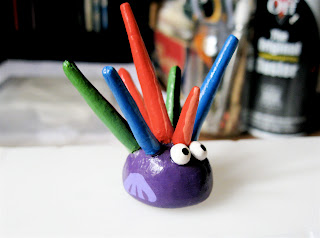Awhile back I posted a recipe for homemade polymer clay. I recently viewed the post and saw all the questions that readers had asked in their comments. Rather than answer each individually, I thought I'd post a follow-up that answers the most frequently asked among them. So, here goes:
Can you add color while the clay is wet?
Yes, you can add acrylic
paint or even food coloring, but for even tinting throughout, you'll want to do
it while the mixture is still liquid. If you want a
swirly effect, then add it to the dough. Be prepared for color-stained fingers.
And also note that adding a lot of colorant will alter the recipe and affect
how the clay performs.
Does the clay shrink as it
dries and how much?
It does, about 15-20%.
Absolutely! I usually dry
my items in the oven at about 150°F. How long to keep them in depends on their thickness. Also, if
you’re making flat shapes, watch them for curling. Periodically flip them over
to keep that to a minimum.
Will dried items stand up
to water?
Dried items are water
resistant but not waterproof, so if they get a little wet it’s OK, but don’t
submerge them in water or even subject them to wet environments. They’ll
certainly do better if they’re sealed with polyurethane or acrylic or the like.
I haven’t tried but
wouldn’t risk it. Dried items are water resistant but not waterproof. A sealant
will help but I still wouldn’t expect them to last very long, especially in wet
conditions.
Can dried items be used
for food?
No. While the clay does
plasticize during the curing process, it won't stand up to extended exposure to
moisture.
Can the clay be used to
make shapes with cookie-cutters?
Absolutely! Sprinkle a bit
of cornstarch on the surface and roll it out on wax paper, or even in a pasta
machine. Flip your shapes over throughout the drying process to keep them flat
(they tend to curl).
Can you use glue other
than Elmer’s Glue-All?
I haven’t tried but any PVA
(polyvinyl acetate) glue should work, with, I would expect, somewhat different
but probably OK results.
Shouldn’t be a problem. If
it is, your clay might be too dry. Be sure to keep it in an airtight container
between uses and only take out what you intend to use immediately.
Stickiness?
Cook the mixture for longer or use a bit less glue.
Once out of the pot stickiness is harder to fix but sometimes adding more
cornstarch helps. Altitude and likely also humidity will affect how the recipe
performs.------------------------
* Not homemade Sculpey or Fimo. The polymer base of those products is polyvinyl chloride (PVC), while for this one it is polyvinyl acetate (PVA). Both PVC and PVA are polymers, and both this clay and commercial polymer clay “plasticize” during a curing process. This clay therefore has many of the characteristic properties of commercial polymer clay (elasticity, pliability, flexibility, durability), but it doesn’t have all of them (particularly insolubility).
Until next time --
Linda
Purty Bird







10 comments:
Hi! Can i use this recipe to make flower pots? Maybe i could put small holes at the bottom just like the normal pots so as not to retain moisture. You think it would work? Thanks!
I don't think it would work for flower pots, unless they're purely decorative -- meaning, not going to hold dirt and water and the other stuff plants need to grow. You can only put dry things in it. The clay isn't waterproof. Thanks for your comment!
Hi! i was wondering if i could use "polybond universal" glue for this recipe. and i would like to thank you for your awesome recipe as there is no polymer clay in sale on my small island, well not that i known of or where!
well it looks to me that all the questions I was going to ask have been covered, thanks for this page and answering the questions.
I've got one question that hasn't been covered: for how long will this stuff store in the fridge or freezer?
ruth
Would this product work in a fondant and gum paste mold set? The mold has the alphabet and I am wanting to place a sripture on a PAINTING. The letter on the molds are thin somewhat small. would I just push dough into mold and let dry (which would take forever to write entire scripture)or push it back out immediately and let dry. Also will dash of cornstarch keep from sticking?
Nicely done on answering the questions from previous post.
so bummed that this didn't work for me-it was too sticky to work with, but cooking it longer just made it cement to the bottom of the pot...too bad!! Also was a challenge to clean the pot after...
The previous article was really informative and this follow up does a good job of clearing up many of my questions.I still have a few questions such as
1.Will cornflour work instead of cornstarch?
2.Will real lime/lemon juice work rather than a bottled version?
3.How long can it be stored?
Thank you so much for the help :)
God bless :)
One of the last questions on prior posting was about bugs eating these items. Has this problem occurred with using the PVA glue versus a plain white glue (not sure if certain preservatives are in the wood glue versus the white glue...)? Hope that question makes sense...
Post a Comment